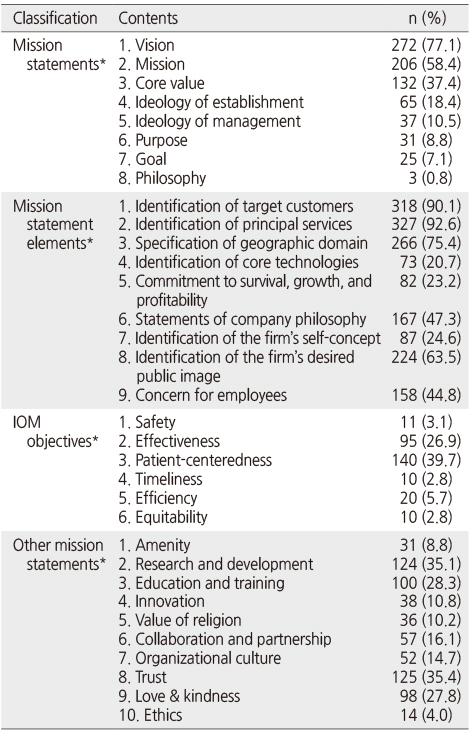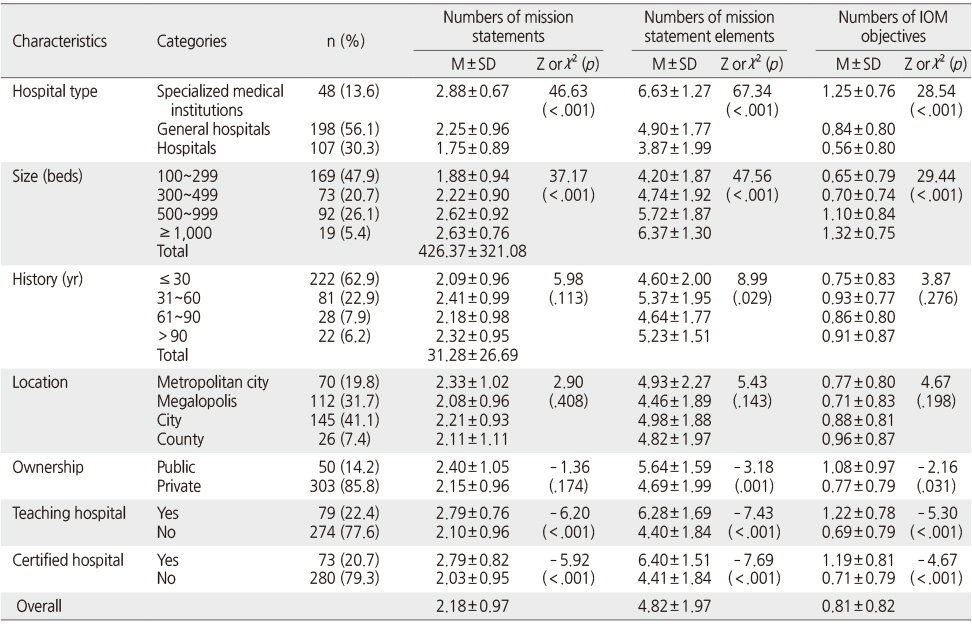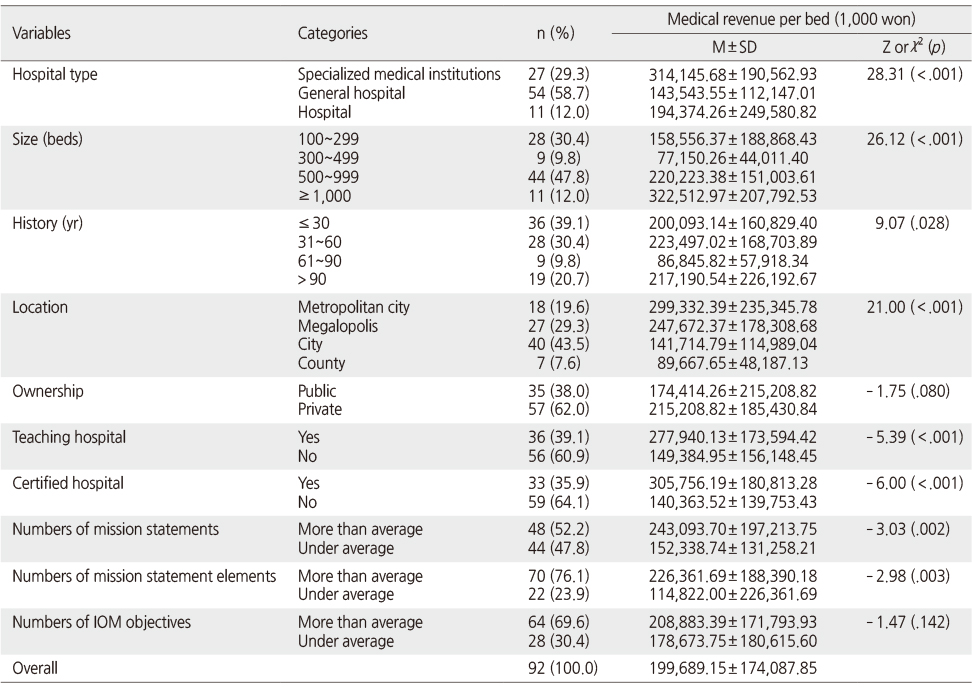Articles
- Page Path
- HOME > J Korean Acad Nurs > Volume 45(4); 2015 > Article
-
Original Article
- Analysis of Mission Statements and Organizational Performance of Hospitals in South Korea
- Eun-Kyung Kim, Se Young Kim, Eunpyo Lee
-
Journal of Korean Academy of Nursing 2015;45(4):565-575.
DOI: https://doi.org/10.4040/jkan.2015.45.4.565
Published online: August 31, 2015
1Department of Nursing, Chungbuk National University, Cheongju, Korea.
2Department of Nursing, Changwon National University, Changwon, Korea.
3College of Nursing, Eulji University, Daejeon, Korea.
- Address reprint requests to: Kim, Se Young. Department of Nursing, Changwon National University, 20 Changwondaehak-ro, Uichang-gu, Changwon 51140, Korea. Tel: +82-55-213-3576, Fax: +82-55-213-3579, sarakimk@changwon.ac.kr
© 2015 Korean Society of Nursing Science
This is an Open Access article distributed under the terms of the Creative Commons Attribution NoDerivs License. (http://creativecommons.org/licenses/by-nd/4.0/) If the original work is properly cited and retained without any modification or reproduction, it can be used and re-distributed in any format and medium.
Abstract
-
Purpose
- The purpose of the study was to examine mission statements and their elements and to investigate correlations between mission statements and organizational performance.
-
Methods
- The current research was a descriptive study based on the examination of mission statements of 353 hospitals that posted mission statements on their webpage and 92 hospitals that made their income statements public.
-
Results
- The most common mission element was 'identification of principal services', which accounted for 92.6%. Mission statements of hospitals included the average of 4.82 mission elements out of 9, and the objective of medical quality improvement was 0.81 among 6 objectives of IOM (Institute of Medicine). Net profit of hospitals with mission statements that have above average number of mission elements were significantly higher (t=2.71, p =.008) than those of other hospitals. Net profit was significantly correlated with mission statements (r=.26, p <.001), and mission elements (r=.29, p <.001).
-
Conclusion
- The results of the study empirically reveal that mission statements in the hospital affect organizational performance. That is, better organizational performance is shown for hospitals with better, more diversified, and more firmly stated mission statements which include identification of target customers, identification of principal services, contribution to society as a non-profit organization, and concern for employees.
- 1. Zuckerman AM. Creating a vision for the twenty-first century healthcare organization. J Healthc Manag. 2000;45(5):294–305.Article
- 2. Smith M, Heady RB, Carson PP, Carson KD. Do missions accomplish their missions? An exploratory analysis of mission statement content and organizational longevity. J Appl Manag Entrep. 2001;6(1):75–96.
- 3. Leuthesser L, Kohli C. Corporate identity: The role of mission statements. Bus Horiz. 1997;40(3):59–66. Article
- 4. Kim HH. A study of performance management on nonprofit social welfare organization by BSC [master's thesis]. Busan, Kyungsung University. 2009.
- 5. Bart CK, Tabone JC. Mission statement content and hospital performance in the Canadian not-for-profit health care sector. Health Care Manage Rev. 1999;24(3):18–29.ArticlePubMed
- 6. Forehand A. Mission and organizational performance in the healthcare industry. J Healthc Manag. 2000;45(4):267–277.ArticlePubMed
- 7. Hwang IK. Financial structural and operational characteristics and management decision-making behavior of the red-figured hospitals. Korean J Hosp Manage. 1999;4(2):305–329.
- 8. Desmidt S, Prinzie AA. The organization's mission statement: Give up hope or resuscitate? A search for evidence-based recommendations. Adv Health Care Manag. 2011;10:25–41.ArticlePubMed
- 9. Bart CK, Hupfer M. Mission statements in Canadian hospitals. J Health Organ Manag. 2004;18(2-3):92–110. ArticlePubMed
- 10. Rarick CA, Nickerson I. An empirical analysis of web-based corporate mission statements. J Strateg E-Commerce. 2006;4(1-2):1–18.
- 11. Smythe WE, Malloy DC, Hadjistavropoulos T, Martin RR, Bardutz HA. An analysis of the ethical and linguistic content of hospital mission statements. Health Care Manage Rev. 2006;31(2):92–98.ArticlePubMed
- 12. Williams J, Smythe W, Hadjistavropoulos T, Malloy DC, Martin R. A study of thematic content in hospital mission statements: A question of values. Health Care Manage Rev. 2005;30(4):304–314.PubMed
- 13. Bart CK, Tabone JC. Mission statement rationales and organizational alignment in the not-for-profit health care sector. Health Care Manage Rev. 1998;23(4):54–69.ArticlePubMed
- 14. Dang JY, Choy YS, Kim YH. A study of mission statements for strategic management: Focusing on the tertiary care hospitals in Korea and special functioning hospitals in Japan. Korean J Hosp Manage. 2013;18(1):70–87.
- 15. Shin HJ. A study on the relationship between mission and performance in hospital organization [master's thesis]. Seoul, Yonsei University. 2004.
- 16. Bart CK. Creating effective mission statements. Recapturing the power and glory of mission is possible with careful planning and implementation. Health Prog. 2002;83(5):41–44. 55. PubMed
- 17. Pearce JA, David F. Corporate mission statements: The bottom line. Acad Manage Exec. 1987;1(2):109–116.Article
- 18. David FR. How companies define their mission. Long Range Plan. 1989;22(1):90–97. Article
- 19. Institute of Medicine. Crossing the quality chasm: A new health system for the 21st century. Washington, DC: The National Academy of Sciences; 2000.
- 20. Bae YK. Influences of core value of enterprise on performance of a corporate's employees [master's thesis]. Seoul, Soongsil University. 2009.
- 21. Richard PJ, Devinney TM, Yip GS, Johnson G. Measuring organizational performance as a dependent variable: Towards methodological best practice. J Manage. 2008;35(3):718–804. Article
- 22. Ministry of Strategy and Finance. Inheritance & gift tax [Internet]. Sejong, Ministry of Strategy and Finance. 2014;cited 2015 May 1. Available from: http://www.law.go.kr/lsInfoP.do?lsiSeq=151988&efYd=20150319#0000
- 23. Peyrefitte J, David FR. A content analysis of the mission statements of United States firms in four industries. Int J Manage. 2006;23(2):296–301.
- 24. Drohan W. Writing a mission statement. Assoc Manage. 1999;51:117.
- 25. Madhok R. Crossing the quality chasm: Lessons from health care quality improvement efforts in England. Proc (Bayl Univ Med Cent). 2002;15(1):77–83.ArticlePMC
- 26. Ryu CK, Yang DH. The relationship between medical service quality and managerial performance in general hospitals. Korean J Hosp Manage. 2006;11(4):82–103.
- 27. Cho DY. The study on the effect of factors on management performance in general hospital. Korean J Health Serv Manage. 2012;6(4):111–120. Article
- 28. Cha JH. The effects of healthcare accreditation system on managerial performances in hospital organizations: Focused on roles of mediating organization competencies [dissertation]. Nonsan, Konyang University. 2014.
- 29. Amran NA. Mission statement and company performance: Evidence from Malaysia. Int J Bus Behav Sci. 2012;2(4):98–107.
- 30. Horvat J, Kedmenec I. Malba. Exploring the quality of mission statements on Croatia's corporate websites. In: Proceedings of the 21st Central European Conference on Information and Intelligent Systems; Varaž in, HR, Faculty of Organization and Informatics; 2010. p. 243–250.
REFERENCES
Figure & Data
REFERENCES
Citations

- The Impact of Patient-centered Care on the Patient Experience according to Patients in a Tertiary Hospital
Jia Kim, Miyoung Kim
Journal of Korean Academy of Nursing Administration.2023; 29(3): 288. CrossRef - Structural Equation Modeling of Person-Centered Nursing in Hospital Nurses
Yeon Hee Bae, Hye-Ah Yeom
Healthcare.2022; 10(3): 514. CrossRef - What is the mission of innovation?—Lexical structure, sentiment analysis, and cosine similarity of mission statements of research-knowledge intensive institutions
Julián D. Cortés, Rosella Levaggi
PLOS ONE.2022; 17(8): e0267454. CrossRef - Validity and Reliability of the Korean Version of Person-Centered Practice Inventory-Staff for Nurses
Sohyun Kim, Sunghee H Tak
Journal of Korean Academy of Nursing.2021; 51(3): 363. CrossRef - A Predictive Model on Patient-Centered Care of Hospital Nurses in Korea
Hyun Jeong, Myonghwa Park
Journal of Korean Academy of Nursing.2019; 49(2): 191. CrossRef
Classification of Mission Statements' Contents of Hospitals (N=353)
*Multiple reponses; IOM=Institute of medicine.
Comparison of Mission Statements by Characteristics of Hospitals (N=353)
IOM=Institute of medicine.
Comparison of Organizational Performance by Characteristics of Hospitals (N=92)
IOM=Institute of medicine.
Correlation Coefficient of Mission Statements, Mission Elements, IOM Purposes, Other Purposes, and Medical Revenue
IOM=Institute of medicine.
Factors Influencing Organizational Performance
*Dummy variables.
*Multiple reponses; IOM=Institute of medicine.
IOM=Institute of medicine.
IOM=Institute of medicine.
IOM=Institute of medicine.
*Dummy variables.
 KSNS
KSNS
 E-SUBMISSION
E-SUBMISSION





 Cite
Cite

